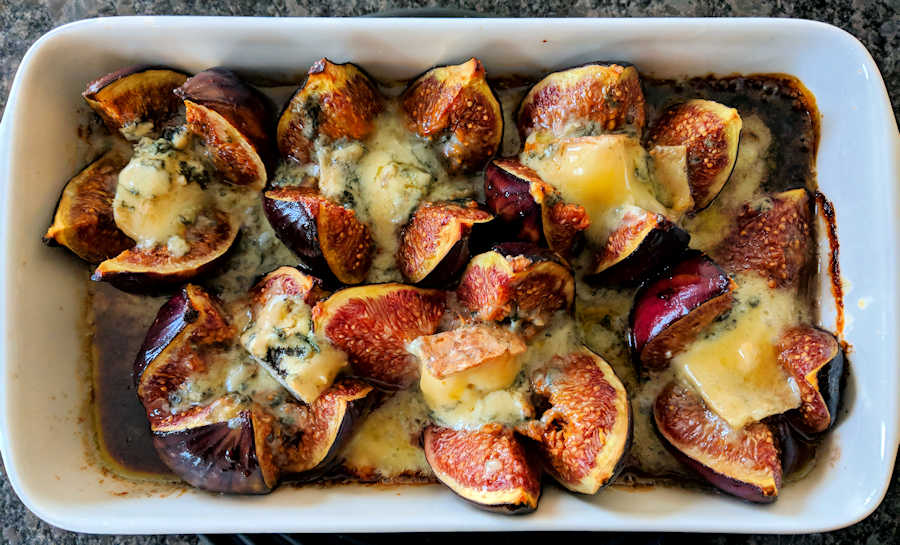Figs and blue cheese - what a good combination! Baked figs stuffed with Gorgonzola or Stilton are a great starter, a side dish or a lunchtime treat. Drizzle with more honey and serve with crème fraiche for healthy dessert too.

How do you like your figs?
I don’t know how you like your figs best but I am happy just looking at them. If you cut one open you see how beautifully it is made, though admittedly it looks slightly obscene according to some artists and writers.
Interestingly, the part of the fig plant we eat is not fruit: it is really flower but growing inside out. That’s only to fool some silly insects into pollinating it, of which more later.
Fig – the stuff of legends
In ancient Rome figs were considered sacred. The mythical city founders, Romulus and Remus, rested under the fig tree while being suckled by a she-wolf who raised them from babies. Those Romans!
Of course, it's not just the fruit: leaves of a fig tree prominently feature in the Bible as the first ever outfit. ‘They knew that they were naked’ and grabbed a fig leaf. We know how THAT story ends. Blame the figs?
And let’s not forget that throughout centuries fig was considered a potent aphrodisiac, again probably based on its appearance. As I said, a bit obscene.
Wasps die in figs
As if all the ancient myths were not enough, there is a fascinating bit of science related to figs. Many types of figs grow male and female fruit which requires wasps to pollinate them. But when a wasp carrying pollen gets inside a female fig, it is not able to lay eggs in there, gets trapped and dies.
Eeew! Are we eating dead wasps in our salads? Fortunately not: the fig’s enzymes make short shrift of the poor wasp’s skeleton and by the time we cut the fruit open, only a memory of the wasp remains.
On the plus side, finally there appears to be something that wasps are useful for.
How to prepare figs?
Fresh ripe figs are a thing of beauty and I do love eating them just quartered, with a drizzle of honey and a squeeze of lemon. You can also add chunks to a green salad to make it more interesting.
But wait till you bake them: figs baked with blue cheese, a bit of honey (optional if very ripe fruit) and a drizzle of balsamic vinegar (an absolute must) are a delight.
What cheese with baked figs?
Any blue cheese will do: I usually have Stilton in the house so that goes. But if I was buying some for the purpose, I might go for the cheapest Danish blue. It will melt anyway.
I'm not too sure about swapping blue for goat’s cheese because I’m not a huge fan of it, but those who like it might go ahead and try. Blue cheese tends to be sharper than goat’s, which is why I choose it to break through the sweetness of the figs and honey.
Cross and bake them
Cutting crosses in the trimmed fruit helps them open up in baking. I like to get them going first in the oven without cheese, so they get a little jammy on their own.
After ten minutes or so, cheese can go into the figs that look at this stage like they've opened their mouths greedy for it.
Another five minutes of baking and it’s ready. The juices released from the figs, combined with honey and balsamic are the most divine tasting thing in the world.
More fig recipes
Unexpectedly, fig pairs beautifully with tomato creating the most vibrant dish of a summer.
Greeks prefer feta with figs – and I don’t blame them. Feta saganaki (a dainty baked snack, a little like Spanish tapas) with caramelised figs is the perfection of sweet vs. salty.
Figs make a wonderful condiment, fig confit, which is gorgeous with cheese or meats and supremely easy to make.
And there’s cake too! Sticky fig upside-down cake is a must in late summer or early autumn, when figs are abundant.